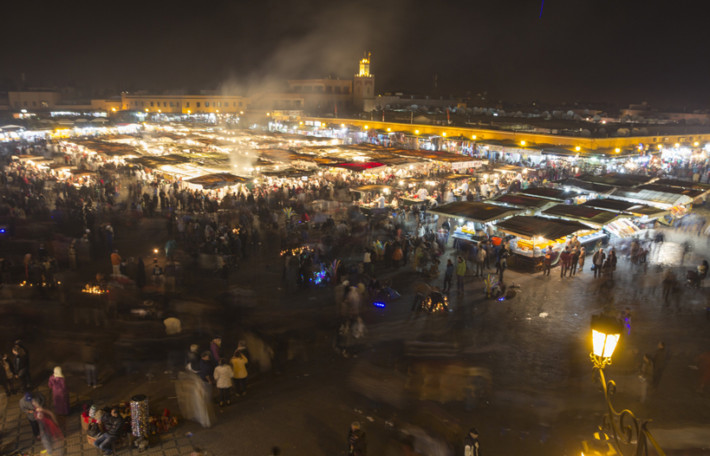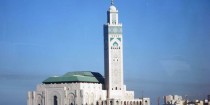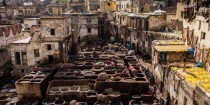Marrakech “Red City” is the most important former imperial city in Morocco‘s history. Situated on the foothills of the snow-capped Atlas Mountains, is also the 2nd largest city in Morocco, with a population of 1,070,000 (2010). Like many North African cities, the city of Marrakech comprises both an old fortified city and a modern city called Gueliz. Marrakech has the largest traditional market (souk) in Morocco and also has one of the busiest squares in Africa and the world, Djemaa el Fna. The square bustles with acrobats, story-tellers, water sellers, dancers, and musicians. By night food stalls open in the square turning it into a huge busy open-air restaurant.
The probable origin of its name is from the Berber words Mur (n) akush, which means “Land of God”. The same word “mur” appears in the names Mauretania, the North African kingdom of the Maghreb during antiquity, and in contemporary Mauritania, the nation-state south of Morocco, although the link remains controversial as these names may also originate from mavros, the ancient Greek word for black.
Until a few decades ago, Morocco was widely known as “Kingdom of Marrakech” to Arabs and Europeans. The European name of Morocco is directly derived from the Berber word Murakush, and in many South Asian languages, the country is in fact still known as “Marrakesh”.
Quik History Marrakesh:
The Koutoubia Mosque built in the 12th century by Almoravids in the 11th century. The Almoravid leader, Abu-Bakr Ibn-Umar decided Aghmat was becoming overcrowded and chose to build a new capital. He decided to build it in the plains near the Tensift River. He chose the site of Marrakech because it was in neutral territory between two tribes who were eager for the honor of the new capital. In 1071 the city was completed by the eventual successor Yusuf ibn Tashfin. The city experienced its greatest period under the leadership of Yaqub al-Mansur, the third Almohad sultan. A number of poets and scholars entered the city during his reign and he began the construction of the Koutoubia Mosque and a new Kasbah.
Back in the reign of Moulay Ismail, Marrakech was the capital of Morocco. After his reign, his grandson moved the capital back to Marrakech from Meknes. For centuries Marrakech has been known for its “seven saints”. The tombs of several renowned figures were moved to Marrakech, attracting visitors from everywhere. The seven saints are Sidi Bel Abbas (the patron saint of the city), Sidi Muhammad al-Jazuli, Sidi Abu al-Qasim Al-Suhayli, Cadi Ayyad ben Moussa, Abdelaziz al-Tebaa and Abdallah al-Ghazwani.
Marrakech was dominated in the first half of the 20th century by T’hami El Glaoui, “Lord of the Atlas”, and Pasha of Marrakech. Sights nearby Marrakech include the valley of the Ourika River in the Atlas Mountains, the valley of the Draa River in the south, near the Sahara desert, the Waterfalls of Ozoud, and Essaouira on the Atlantic Ocean.
Marrakech is an oasis of a great and rich plant variety. Throughout the seasons, orange, fig, permanganate and olive trees spew out their fragrances and display their marvelous colors and fruits. The precious gardens of the city conceal numerous native plants or other species that have been imported in the course of the centuries: Giant bamboos, palm trees, banana trees, cypress, philodendrons, rosebushes, bougainvillea, pines and various kinds of cactus plants. To this date, Marrakech is seen as a gateway from the West to the East.



